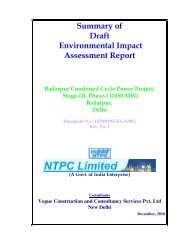Rapid Environmental ImpactAssessment Study <strong>of</strong> the Proposed<strong>350</strong> <strong>MW</strong> <strong>Pragati</strong>-<strong>II</strong> <strong>Combined</strong> <strong>Cycle</strong><strong>Power</strong> <strong>Project</strong> <strong>of</strong> <strong>PPCL</strong>Doc. No.: CW-EN-9384-C-379-E-R-002Rev. No.: R0Issue Date: 21-02-2006Page No: 4 <strong>of</strong> 168.0 PLANT CONFIGURATIONAlthough it is possible to have different arrangements <strong>of</strong> GTG, HRSG and STG, theproposed capacity consists <strong>of</strong> one <strong>of</strong> the following configurations.Alternative IAlternatives-I is developed for (2 GT + 2 HRSG +1 ST) configuration.Alternative <strong>II</strong>This alternative is developed with (1 GT + 1 HRSG +1 ST) configuration.9.0 SOURCES OF POLLUTION AND CONTROLThe various types <strong>of</strong> pollution from the proposed power plant are categorized underthe following types:• Air pollution;• Water pollution;• Solid waste generation; and• Noise pollution.The gaseous, liquid and solid waste generated in the plant will be treated to conformto the statutory requirements.9.1 AIR POLLUTION CONTROL SYSTEMDry Low NOx (DLN) burners shall be provided along with the gas turbines to controlNOx emission at source within 35 ppm against the statutory limit <strong>of</strong> 75 ppm.9.2 WATER POLLUTION CONTROL SYSTEMSAll the liquid effluents would pass through a Central Monitoring Basin (CMB) t<strong>of</strong>acilitate monitoring <strong>of</strong> flow and important parameters. All the effluents emanatingfrom plant will conform to the regulatory standards <strong>of</strong> Ministry <strong>of</strong> Environment &Forest (MoEF) and Delhi Pollution Control Committee (DPCC).9.3 NOISE POLLUTION CONTROL SYSTEMSIn order to control the noise pollution from the project, reduction in noise levels shallbe achieved through built-in design requirements <strong>of</strong> equipment, proper lay out design<strong>of</strong> the buildings and plant area, adding the sound barriers, provision <strong>of</strong> green beltand afforestation, use <strong>of</strong> enclosures with suitable absorption material etc. will furtherhelp in reducing the noise levels.EXECUTIVE SUMMARYMANTEC CONSULTANTS (P) LTD., NEW DELHI
Rapid Environmental ImpactAssessment Study <strong>of</strong> the Proposed<strong>350</strong> <strong>MW</strong> <strong>Pragati</strong>-<strong>II</strong> <strong>Combined</strong> <strong>Cycle</strong><strong>Power</strong> <strong>Project</strong> <strong>of</strong> <strong>PPCL</strong>Doc. No.: CW-EN-9384-C-379-E-R-002Rev. No.: R0Issue Date: 21-02-2006Page No: 5 <strong>of</strong> 1610.0 BASELINE ENVIRONMENTAL SCENARIOThe baseline environmental status for various environmental attributes within thestudy area has been established through field monitoring supported by data fromsecondary sources. The environmental disciplines studied include land-use, wateruse, demography, socio-economic, geology, soils, hydrology, water quality,meteorology, air quality, terrestrial and aquatic ecology and noise.10.1 LAND USEThe land use pattern has been established based on interpretation <strong>of</strong> satelliteimagery <strong>of</strong> 2005 <strong>of</strong> the study area with limited ground truth verification. Land usepattern based on satellite imagery shows that the agriculture land (9.23%),settlements (43.84%) and water bodies (6.92%), barren land ( 7.85%), forest area(1.76%) and plantation ( 30.40%) are present in the study area.10.2 HYDROLOGYThe study area has unconsolidated alluvial soils <strong>of</strong> recent origin and restricted togood ground water availability. Aquifers in the study area are generally <strong>of</strong> two types:shallow aquifers and deep aquifers. In general the ground water flows towardsYamuna River in the study area. The main source <strong>of</strong> recharge <strong>of</strong> ground wateraquifers is rainfall infiltration and the other source being seepage from Yamuna anddrains.Annual rain flow, canal water inflow and ground water draft is 204.20 MCM,7900MCM and 28.80 MCM respectively in the study area. The evapotranspiration,Evaporation, Domestic consumption, Industrial consumption, Ground waterrecharge, Yamuna seepage, Run-<strong>of</strong>f, <strong>of</strong> the study area is 94.9, 17.53, 436.61,88.00, 6.13, 37.00, 7452.83 MCM respectively. Total inflow and out flow <strong>of</strong> thestudy area is 8133.00 MCM10.3 DEMOGRAPHY AND SOCIO-ECONOMICSAs per Census Data <strong>of</strong> 2001, total population <strong>of</strong> the study area is 88,60,730.Percentage <strong>of</strong> male and female population <strong>of</strong> the study area is 54.99 % and 45.01%.Percentage <strong>of</strong> Schedule Caste population <strong>of</strong> total population is 16.62%. Percentage<strong>of</strong> literacy in the study area is 69.67%. Percentage <strong>of</strong> total worker , marginal workerand non worker is 31.14%, 1.65% and 67.22 % <strong>of</strong> total population respectively.The urban area falling under the radius <strong>of</strong> study area has all the necessary civic andother amenities, however the villages have inadequate civic and other amenities.10.4 GEOLOGYThe city area <strong>of</strong> New Delhi is slightly undulating with level tract occurring at places.The outskirts <strong>of</strong> few <strong>of</strong> the west are higher in elevation than the city area itself.Consequently, the city area has a gradual slope from West to East. The plateau thinsout northwards to form famous ridge, which runs through urban areas <strong>of</strong> Delhi. RiverYamuna flows from north to south through the eastern part <strong>of</strong> Delhi. The YamunaRiver, flowing in a southerly direction along the eastern boundary is the onlyEXECUTIVE SUMMARYMANTEC CONSULTANTS (P) LTD., NEW DELHI
















